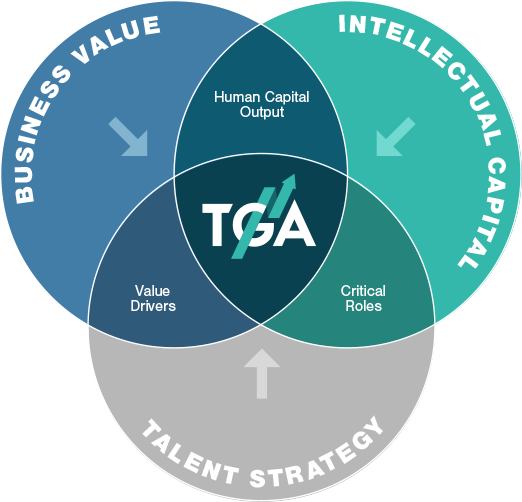2023 Talent Analytics Playbook for CHROs

By Tom McGuire | January 28, 2025
The explosion of HR tools, technology and trends makes zeroing in on essential analytics more difficult than ever. How should Talent Analytics define HR priorities? What are the greatest obstacles to achieving effectiveness? What does a Talent Analytics "homerun" look like? In 2023, talent analytics should not just support, but fundamentally drive, your organization's business strategy.
What is the most important use of talent analytics and insights for CHROs?
The energy and interest in using talent analytics to drive success for HR organizations is strong – and has shifted from simply fixing HR reporting to truly utilizing information that can create business value. A recent TGA survey of CHROs indicated that the most important use of talent analytics was to inform continuous improvement of existing talent practices. Other uses were more nuanced and included predicting burnout rates in certain high-stress jobs to modeling future diversity rates based on current data trends.
Survey participants reported:
“We are re-building our talent acquisition process from ground zero and analytics provide the business case and let’s us tell the story about where we need to go.”
“Predictive analytics can reduce burn and churn and lead to a more stable workforce.”
“We had a hunch about what was happening and used data to test our hypothesis. We’re learning to use data and analytics to prove or disprove what we suspect to be the case.”
What do Talent Analytics allow HR teams to achieve?
HR continues to suffer the positioning as a cost center within respective organizations across most industries. This is in contrast to the oft stated belief that talent is an organization’s most important asset. The reasonable conclusion seems obvious: talent spending (at least some significant part) is in fact an investment rather than a cost. Analytics that can prove and improve the return on talent spend can be decisive in changing the perception of HR as merely “just more overhead”.
How can Talent Analytics help us improve our current state?
Current state analytics typically serve multiple uses including updates to management on HR program activity, planning workforce needs, and tracking hiring results. But often, such reports are not targeted / prioritized, nor do they yield specific continuous improvement efforts. To complicate matters, it’s often unclear what the true priorities are and who is responsible for improving key metrics. CHROs across all industries also report imitations with the accuracy and completeness of information inhibit these higher level uses in current state.
Given these realities, objectively and accurately (to the extent possible*) measuring and reporting on baselines (e.g., hiring speed, cost, quality and diversity and retention trends by key roles and availability of talent) will enable a discussion about which are truly the most important outcomes that need further focus. In turn, this will highlight the business priorities and provide a roadmap for continuous improvement efforts.
*How accurate is HR data?
Survey respondents reported that HR data quality is “middle of the road” – some accurate, some aren’t. As a practical matter, there isn’t a lot of difference between this and all the data being inaccurate. In fact, the latter might be better – at least you are certain that what you are looking at is wrong. On the other hand, 50% accurate data yields 100% negative credibility.
Why is data inaccurate?
“At best, HR data is a snapshot in time which is often altered later by human intervention.”
“In accounting, once you close the books, the data is finalized – in HR, change happens constantly without an end point. This leads to data capture problems and ultimately credibility issues.”
TGA estimates that 30% of data sets received from our clients during audit engagements is obviously erroneous or incomplete. Examples include “time to fill” numbers of one day for requisitions, turnover data that includes employee tenure in negative numbers or reports from different sources that include a variance in raw data. Because our work involves completing deep analysis on HR data, we typically remove that data and rely on the remainder of the data set to tell a more accurate story – which arguably is statistically reasonable.
Conversely, and based on detailed reviews of internal client reporting, utilizing the full data set as is normally the case, HR reports can be significantly inaccurate and sometimes leads the user to an opposite conclusion than that which is supported by the facts. For many organizations, HR data credibility is so low that fixing the data at its source (where it is entered) should supersede other analytic investments.
What most improves organizations’ approach to talent analytics?
Analytics expertise and access to all relevant data (across payroll, HCM, performance management, ATS, etc. systems) is key to reporting accurately on hiring and retention outcomes. It is also necessary to identifying gaps in data capture or accuracy and identifying what needs to change in order to ensure sustainable TA and TM data and reporting integrity. A requirement is clearly defining the true capabilities required, responsibilities, measures of success and access needed for the successful implementation of such an analytics role.
How do I provide an accurate assessment of my HR team’s Return on Investment (ROI)?
In the 2023 talent marketplace, the highest and best use of HR is finding, winning and retaining high performing, diverse talent. HR value delivery must then measure talent quality – not by asking hiring managers what they think about candidates or the recruiting process – but by objectively measuring the quality of those hired and retained. This method merges the analysis of recruiting results (speed, cost, diversity) with performance and retention data to produce not only an objective measurement of quality but also insights into how and where the highest quality talent is found, so we can continue to mine these sources. Measuring the quality of talent acquisition and talent management efforts is core to the future of talent analytics, particularly in the current labor marketplace.
Conclusions
Talent analytics can be thought of as a 3-legged stool: 1) data; 2) analysis; and 3) derived insights. Flaws in any of these legs topples the entire effort. Regarding the first leg, data accuracy and completeness is fundamental and the key to credibility. This is often a stumbling block for many HR organizations. There are three elements essential to solving data accuracy and completeness:
Process – the processes by which data is entered (or not entered as the case may be) into any given database must be clearly defined, documented and auditable. Who, what, when and how data is entered should be transparent to all involved and each should be held accountable for following these standards.
Detection – steps to detect data errors and omissions should be included in the process design. Accounting, for example, has its famous double-entry scheme (debits=credits) which solves the bulk of potential financial data problems. Unfortunately, that is not likely to be replicated within HR, but it is a relatively simple matter to implement automated data exception reporting. Accountability for reviewing and addressing exception report issues is key to the effective detection of errors and omissions.
Remediation – fixing the root cause of data issues discovered in detection is the last step. Generally, this requires either implementing change to the process or addressing entry problems, systems integration issues, or maintenance accountability lapses.
Analysis of reliable data requires skilled and knowledgeable people. This is not a technology skillset, but rather an analytical one with a strong dose of curiosity and ability to connect the dots – a strong sense for causation versus correlation. This last qualification requires some level of HR subject matter expertise but can also be acquired on the job.
The Endgame:
The ability to take solid and valid analysis and draw meaningful insights to fuel decisions and change is the endgame. Again, the skillset here is essential; strategic, analytic, business-savvy, and having sufficient subject matter expertise. Deriving and communicating strategic insights is the true value-add to talent analytics work – but of course none of this is possible without the other 2 stable legs.
The demand for analytics and the information that can be delivered to support business decisions is real. Yet, the current state for most HR organizations includes serious data flaws and a lack of qualified and knowledgeable analytics practitioners. Multiple studies (including TGA proprietary studies) show that intellectual capital, the output of people, accounts for more than 80% of the average business’ market value – and that this value is disproportionately contributed by certain roles, usually dependent on the industry they operate within (e.g. pharma, tech, consumer products, etc.) Talent analytics by definition can therefore add the most value by concentrating on these critical roles. Improving the quality of hiring and retention efforts for these roles will yield potentially powerful results for any business.
Interested in learning more about how to dramatically and rapidly improve your talent analytics? Contact us at info@talentgrowthadvisors.com.

Email Updates
Get notified when we update our blog.
Learn More
Not All Employees Are Equal: The Importance of Strategic Human Resource Management
Read ThisLearn more about our unique approach to Talent Strategy Formulation.
Our Bloggers

Linda Brenner
Linda is an industry vet with keen observations and a knack for calling it like it is.

Tom McGuire
Tom brings the unlikely blend of Finance & HR to the practice, illuminating readers with the link between talent and business value.